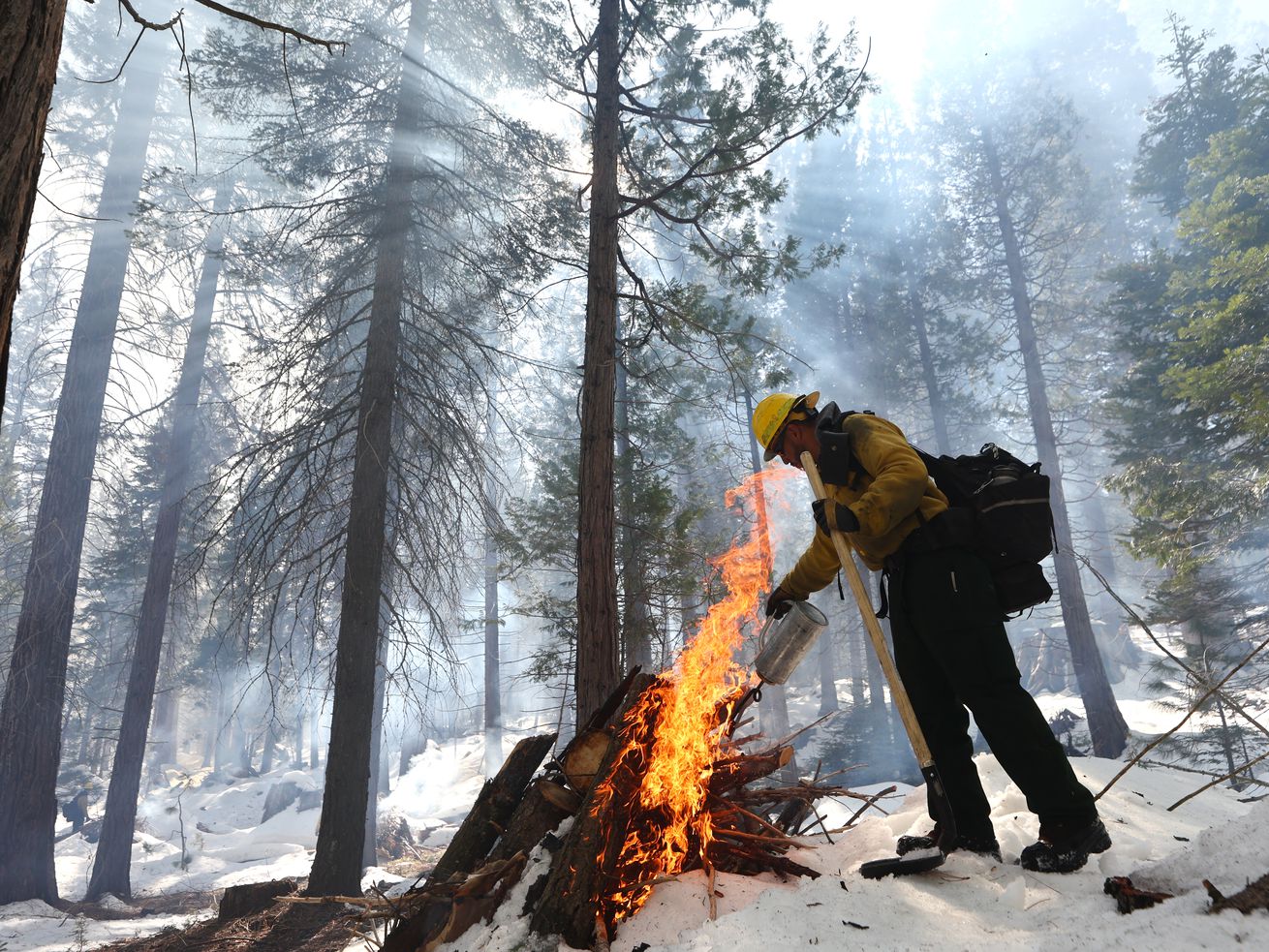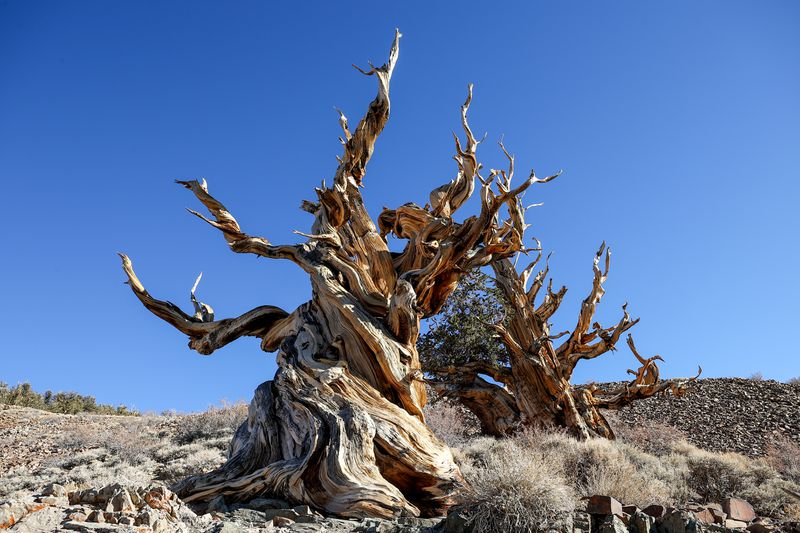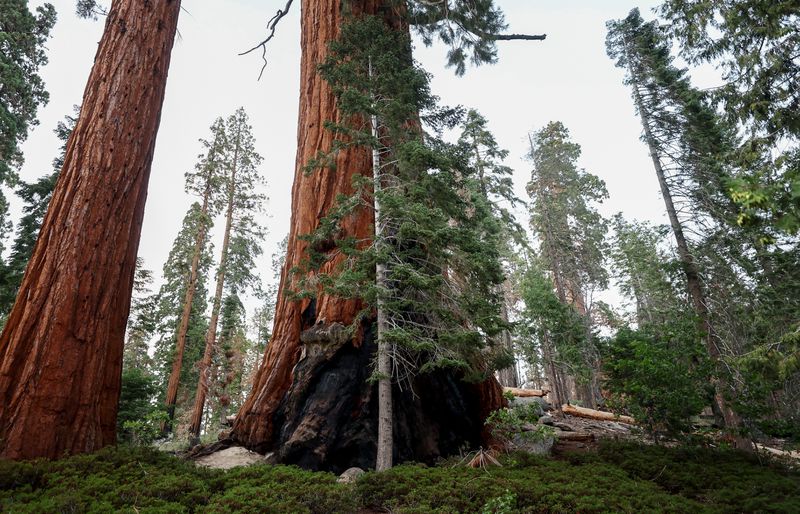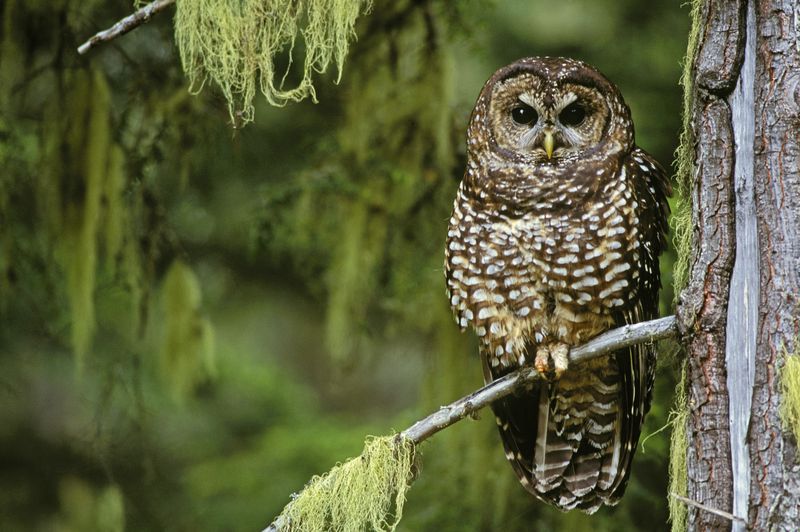
A firefighter burns a pile of wood to reduce the amount of fuel in California’s Sequoia National Forest. | Mario Tama/Getty Images
Biden wants to restrict commercial logging in old-growth forests. Could that make wildfires worse?
In the dry mountains east of Fresno stands a pine tree that’s more than 4,800 years old. The tree, a bristlecone pine with a thick trunk and cartoonish branches, was alive when Egyptians built the pyramids, when Romans constructed their capital city, and hundreds of years before English settlers arrived on the East Coast.
Known as Methuselah, the pine is perhaps the planet’s oldest living organism, though it’s just one of the nation’s many ancient trees. Some giant sequoias, found elsewhere in California, are more than 2,000 years old. So are certain bald cypress trees in North Carolina. These trees are true elders, and our lives are but a blip in theirs.

Tayfun Coskun/Anadolu Agency via Getty Images
An ancient Great Basin bristlecone pine tree known as Methuselah in California’s Inyo National Forest.
Old trees like these are now at the center of a longstanding controversy over how to manage the nation’s forests — and the valuable resources they contain.
In December, the Forest Service, a federal agency that manages about a fifth of all forested land in the US, proposed to sharply limit commercial logging in its old-growth forests, which cover nearly 25 million acres across the country. The Service aims to finalize the proposal by 2025. (Should the White House switch hands, the proposal may go nowhere.)
On the surface, the proposal — rooted in an executive order signed by Biden on Earth Day in 2022 — sounds straightforward. Old-growth forests, which are typically home to older trees and cover only a small chunk of the US, are important refuges for birds and other wildlife, many of which are threatened with extinction. They also store and absorb huge quantities of carbon that would otherwise accelerate climate change. Old-growth forests are worthy of protection, and that’s what this proposal aims to do.
Yet in reality, what it takes to protect old-growth forests isn’t clear-cut.
Many environmental advocates say it requires banning commercial logging, not only in old-growth forests, but also in those that are “mature,” the stage before old-growth. That’s well beyond what the government has proposed. The timber industry, meanwhile — and to an extent the Forest Service itself — argues that logging can make forests healthier and more resilient.
Complicating this dispute is the shifting threat to the nation’s forests. While logging eroded most old-growth forests in centuries past, climate change now threatens to destroy what little of these habitats remains.

Mario Tama/Getty Images
A stand of giant sequoia trees in Sequoia National Forest in south-central California.
What exactly is an “old-growth” forest?
An old-growth forest is basically a forest with lots of old trees. From here, most explanations tend to fall off a cliff of interpretability.
The main challenge in defining old-growth is in defining “old.” Some trees, like redwoods, can live for thousands of years. Others, like dogwood, only live for decades. There’s no universal old age, no universal marker of old-growth.
Instead, scientists typically look for proxies of old-growth. These include things like the diameter of trees and their branches, the number of layers in the canopy, and the amount of dead wood on the forest floor. But again, these attributes vary by region. Some old forests, for example, are adapted to frequent fires, so they look very different.
Ultimately, this means that various research teams define old-growth somewhat differently and, in turn, come up with different estimates for the extent of old-growth forests in the US.
In this case, what matters most is the estimate by the Forest Service, which could determine where the government will restrict logging. In a report last spring, commissioned by the Biden administration, the agency estimated that there are nearly 25 million acres of old-growth forest on Forest Service land — or about 17 percent of the agency’s forested land — based on a complex set of definitions tailored to some 200 forest types. These forests include everything from the sprawling pinyon and juniper woodlands of the West to the oak and hickory forests to the east.
The Forest Service also identified an additional 68 million acres of “mature” forests — i.e., forests that are old but don’t yet meet the definition of old-growth. The Biden administration’s proposal doesn’t add logging restrictions to these forests.
Why these old trees matter so much
Before European settlers arrived, old forests covered vast stretches of the US and were managed in many regions by Indigenous tribes. Beginning in the 1600s, however, the timber industry emerged and ate its way through old-growth forests, from east to west. By World War II, much of the remaining old-growth forest was within public lands managed by the Forest Service.
Then, following the war, demand for housing surged. Companies — at the government’s behest — began logging national forests, too, including old-growth. This wasn’t scandalous. Historically, the Forest Service and timber industry were allies; they tended to view old-growth forests as unproductive and wasteful. National forests, then and now, were meant to be managed for multiple uses, including the production of timber.
Today, only a small fraction of the country’s old-growth forests remain. And they are precious. Scientists now know that these ecosystems as they naturally exist — with or without consideration for human wants and needs — are far from unproductive. Indeed, the health of the planet depends on them.
For one, old trees are exceptionally good at capturing and storing carbon. Old-growth forests tend to have larger trees than younger stands, and larger trees are made of more carbon-rich wood. They also typically have larger leaf-filled canopies, which operate like sponges, sucking in carbon dioxide from the air, helping to offset the impacts of greenhouse gas emissions. (There’s disagreement among scientists about whether, on a per-area basis, old-growth forests absorb more carbon than new-growth; it likely depends on the kinds of trees. What’s clear is that old-growth forests store more carbon than younger forests.)

Greg Vaughn/VWPics/Getty Images
Northern spotted owls are among the many animals that depend on old-growth forests.
Old forests are also tremendously important for wildlife. Birds like the marbled murrelet and mammals like the red tree vole need them to survive, said Matthew Betts, a forest ecologist at Oregon State University. It has to do with the forest structure. Big branches unique to older trees, for example, provide support for nests, and the thick layers of canopy help retain water. Many lesser known species including types of mosses, lichens, and insects — which help maintain these systems — rely on these habitats, too, Betts said.
As the planet warms, old-growth forests will become even more important for the nation’s wildlife. In 2017, Betts published a study showing that old-growth forests likely help buffer the negative impacts of rising temperatures on birds, likely, in part, because big trees with large canopies help cool the landscape.
“You walk into these places and it’s like outdoor air conditioning,” said Dominick DellaSala, chief scientist at Wild Heritage, a project of the nonprofit Earth Island Institute, who was not affiliated with the study.
These and other reasons — the cultural significance of old tree groves, the role they play in water cycles, and so on — are why environmental advocates have for years been fighting to stop commercial logging within remaining stands of old-growth forests. To that end, the Biden administration’s proposal is a start. Yet some say it doesn’t go far enough. Critically, it leaves out forests that are mature and will become old-growth in time, yet are not technically old-growth today.
“Just protecting the existing old growth when almost all of it has already been eliminated is just not even a half measure,” said Jim Furnish, a forester who formerly oversaw the national forest system at the Forest Service. “The Forest Service views that entire landscape of mature forests as the playing field for timber industry now.”
In an interview with Vox, Chris Swanston, the Forest Service’s climate adviser and director of the agency’s office of sustainability and climate, emphasized that mature tree stands in national forests will — assuming they’re not intensively logged — eventually become old-growth forests. At that point, they’ll receive added safeguards under the new proposal. Old-growth is a status, not a place on the map, he told Vox.

Mathieu Lewis-Rolland/Getty Images
Firefighting helicopters fly above the Patton Meadow Fire near Lakeview, Oregon, on August 14, 2021.
Representatives of the timber industry, meanwhile, say that further restricting logging in these habitats will backfire. The new proposal could actually put these forests at an even greater risk of disappearing, they say, by making them more likely to burn. This claim is not entirely unfounded.
Wildfire makes the debate over logging old-growth even more complicated
It’s not surprising to see environmental advocates and timber companies at opposite sides of a debate about logging. Climate change (and meddlesome humans), however, adds a bit of a twist.
As summers get warmer and dryer, especially in parts of the West, forests become more likely to burn. Past decades of intentional fire suppression by the US government have only added fuel. Between 2000 and 2017, the annual average area burned by large fires more than doubled, compared to the period between 1984 and 1999, according to the Forest Service. “The total area of high-severity fires, as well as the volume of trees killed annually by fire, is expected to increase further by 2070,” the Service reported.
Fire — not logging — is now the main threat to old-growth forests, according to the Forest Service.
Scientists have long known that, in certain forests, manually removing some trees and clearing out brush in the understory can help protect forests from burning down by essentially removing excess fuel. This process, known as thinning, is sometimes followed by controlled burns. Thinning to reduce the risk of fire is allowed in old-growth forests under Biden’s proposal.
Foresters aligned with the timber industry point out that logging can be used as a kind of thinning, even if the objective may be different. If done right, logging removes flammable fuel wood from the forest, some of which has only accumulated because of fire suppression (meaning it arguably wouldn’t be there had the government not suppressed fires in the first place).
“The Forest Service’s approach here is baffling,” Bill Imbergamo, the founding executive director of the Federal Forest Resource Coalition, an industry group, said in a statement after the Biden administration announced the proposal. “Congress has made it clear that job one is reducing the threat of catastrophic fires by thinning our National Forests, something our industry is more than capable of doing.”
There are cases when commercial logging has helped reduce the intensity of fires. Parts of the southern Sierra Nevada mountains, for example, have been spared from large blazes because they were selectively logged, according to a federal forest scientist. (The scientist asked to remain anonymous because he wasn’t authorized to speak to the press.) Similarly, some national parks, which are more narrowly focused on preserving the natural environment, have logged some of their lands and sold the wood to reduce wildfire risk, the scientist said.

Mario Tama/Getty Images
Smoke from a prescribed burn rises above Sequoia National Forest.
There are even examples of when logging old-growth forests has apparently benefited wildlife, particularly species that are more dependent on younger trees. Following decades of fire suppression in parts of Michigan, jack pine forests aged into old-growth stands with fewer, larger trees. That was a problem for Kirtland’s warbler, according to the Forest Service, perhaps because the bird requires dense young stands of pine that help hide its ground-level nests. Logging the old forest and planting saplings created an environment that helped the species recover.
The upshot: Logging is not always bad, though it depends on how you define it and what purpose it serves. Removing a small number of trees in a dense understory, especially in places with a long history of fire suppression, may help forests avoid catastrophic blazes. Again, these sorts of actions would be allowed under Biden’s proposal. (Commercial logging also helps fund other activities within the Forest Service, according to Greg Aplet, a forest ecologist and director of special projects at The Wilderness Society, an environmental nonprofit.)
“As we are fostering old growth that is resilient to climate change, and all of the various threats associated with climate change, logging is a piece of that,” Swanston said. “It can help reduce hazardous fuels. It’s really not about locking out management.”
What’s more clearly a problem — from a carbon and biodiversity point of view — is logging for the primary purpose of commercial gain. That could include clearcutting a section of old-growth forest or taking out larger, older trees, actions that tend to be more profitable. This sort of logging typically doesn’t benefit forests or prevent them from burning, according to several forestry experts. Plenty of studies show that old trees and many old forests, like those comprising coast redwoods, are resilient to wildfires.
History matters, too. In some cases, past logging has made forests more likely to burn today, said Peter Fulé, a professor of forestry at Northern Arizona University. Younger trees that spring up after removing old growth have branches closer to the ground that can function as “ladder fuels,” helping flames rise into the canopy.
In a sense, Biden’s proposal is subtle. It doesn’t so much ban logging in old-growth forests as it does put a big asterisk on it — should anyone cut down trees, they must do so with the primary objective of protecting them from wildfires, disease, and other threats. It’s also worth noting that only a small portion of commercial timber in the US comes from old-growth forests. This proposal, at face value, isn’t a major blow to the timber industry.
Yet it represents a significant shift in the way the US views the role of its forests. Long aligned with the timber industry, the Forest Service historically valued trees as a source of timber. It still does, but now more than ever the agency acknowledges a suite of other benefits trees provide to the American public, such as their role in reining in climate change by providing carbon storage — and that requires keeping them in the ground.
——————————————-
By: Benji Jones
Title: Why saving old trees is weirdly controversial
Sourced From: www.vox.com/down-to-earth/2024/1/12/24023876/biden-forest-service-proposal-old-growth-forests
Published Date: Fri, 12 Jan 2024 13:00:00 +0000
Read More
Did you miss our previous article…
https://politicscope.com/social-issues/what-would-a-trump-2-0-economy-look-like/
I'm a writer for lifestyle publications, and when I'm not crafting stories, you'll find me cherishing moments with my family, including my lovely daughter. My heart also belongs to my pets—Sushi, Snowy, Belle, and Pepper. Besides writing, I enjoy watching movies and exploring new places through travel.

